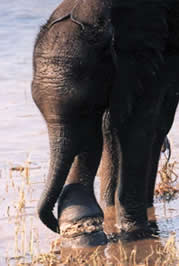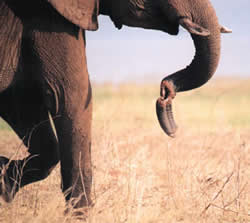| |
Back to Index
Elephants
in distress
Zimbabwe Conservation Task Force (ZCTF)
October 30, 2004
We desperately need to track down the affected
elephants, tranquilize them and remove the snares but the tranquilizer,
M99 is very expensive and we need a large quantity of it. If anyone
is able to assist us with funds to enable us to purchase this
drug, we would be extremely grateful.
  I
have recently returned from a trip to Kariba where I saw several
elephants that had been unfortunate enough to wander into wire snares
in Bumi Hills and Mapongola Hills. With the decline of the economy,
more and more snares are being laid to capture animals for food
and poaching is on the increase because the locals are starving
and will do anything to obtain food. The snares are probably not
intended for the elephants but they are causing great suffering
and painful lingering deaths amongst these majestic lumbering beasts. I
have recently returned from a trip to Kariba where I saw several
elephants that had been unfortunate enough to wander into wire snares
in Bumi Hills and Mapongola Hills. With the decline of the economy,
more and more snares are being laid to capture animals for food
and poaching is on the increase because the locals are starving
and will do anything to obtain food. The snares are probably not
intended for the elephants but they are causing great suffering
and painful lingering deaths amongst these majestic lumbering beasts.
One can only imagine the amount of pain an elephant endures when
a wire snare becomes embedded in its leg and infection and swelling
sets in, as can be seen in some of the photos
attached.
Some elephants have managed to remove a snare from their leg but
the damage caused to the leg muscle has resulted in a deformity
where one leg will always be much thinner than the others (see
photos)
Many elephants have managed to get their trunks caught in snares
and the wire remains wrapped tightly around the trunk, cutting off
the blood supply until the portion of the trunk below the snare
drops off. An elephant with a shortened trunk may not seem to be
a serious problem but this is actually the most tragic snare wound
of all because an elephant uses the tip of his trunk the same way
we use our hands. He uses it to pull clumps of grass out of the
ground and he then shakes all the sand off it before putting it
in his mouth and eating it. An elephant without a trunk tip can't
do this. He uses his foot to dig the clump of grass up and then
by wedging the grass between his short trunk and his leg, he somehow
manages to eat it but he eats the sand at the same time because
he can't shake it off. Gradually, over a period of time, his molars
wear down from all the sand he has been chewing until eventually,
he can't eat at all and he dies a lingering agonizing death of starvation.
  This
problem is obviously not confined to the Kariba area because people
all over Zimbabwe are starving and snares are being laid wherever
wildlife is present. The Zimbabwean government is pushing to start
culling elephants because they believe there are too many. We are
concerned that all the elephants with shortened trunks will have
a reduced life span and if they start culling the elephants, between
the shortened life spans and the culling, we may end up without
any at all. This
problem is obviously not confined to the Kariba area because people
all over Zimbabwe are starving and snares are being laid wherever
wildlife is present. The Zimbabwean government is pushing to start
culling elephants because they believe there are too many. We are
concerned that all the elephants with shortened trunks will have
a reduced life span and if they start culling the elephants, between
the shortened life spans and the culling, we may end up without
any at all.
I was told during my visit to Kariba that the last 3 lions remaining
in the Fothergill area, have now been wiped out by poachers. The
last picture attached is a lion that was caught in a snare and beheaded.
There is a team of dedicated people currently scouring the Bumi
and Mapongola Hills areas and removing snares from the bush but
they need funds to do the job properly.
We desperately need to track down the affected elephants, tranquilize
them and remove the snares but the tranquilizer, M99 is very expensive
and we need a large quantity of it. If anyone is able to assist
us with funds to enable us to purchase this drug, we would be extremely
grateful.
Visit the ZCTF
fact
sheet
Please credit www.kubatana.net if you make use of material from this website.
This work is licensed under a Creative Commons License unless stated otherwise.
TOP
|

